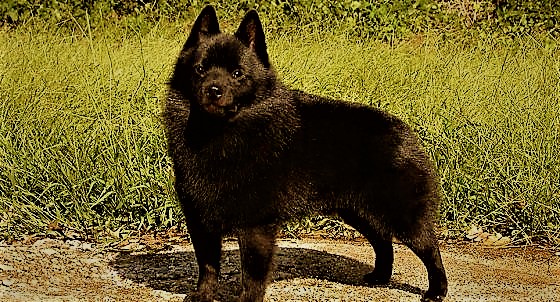There is some must to have features when it comes to showcasing the Schipperke breed. The ears, for example, should not be flat, and must rather be intact. One‘s triangular shape must be clear and upright. If the ears really aren’t like this and display some variation or numbness, the dog is rejected.
The Schipperke head is average in height and shortens towards the nose. It has a slight circular appearance in the picture, and the size of the Schipperke mouth is a little shorter than the size of the head. If you wanted to take a peek at the dog’s head from the above, you’d see a wedge shape, so the upper lip is totally packed underneath the eyes.
The forequarters have a unique appearance of easy-going shoulders and limbs stretching right down the sides. When an individual gazes from the front, that’s what they’re going to witness in the classic Schipperke. The location of the limbs is just below the side profile. Pasterns must be elastic and solid with a wide, small height. As far as the limbs of the Schipperke are concerned, they are firm, round, and thin, with the dewclaws withdrawn.
The buttocks are athletic for the front posture and much smaller than the forequarters. The stilts are twisted and the hocks are quite let down. There are punishments for Schipperkes who display a significant spine curvature.
There is a particular trend in the Schipperke fur in adolescents. The hair length must stick to this standard and develop naturally. It begins with the forward region – the forehead, the forelimbs, the ears, and the knuckles. Medium length is predominant in the body. The fur then keeps growing upon its cape, the culottes, the ruff, and the jabot. Where the fur must lay straight is in the center of the rear of the Schipperke – beginning at the rear of the coat and all along the rump region. You’ll notice in the Schipperke preview that perhaps the hair can be larger than the limb and torso arms, but just a little smaller around the cape. Any non-standard variation in the span of the coat should be subject to massive fines.
Another point of concern is the quality of the suit. It’s supposed to feel a little harsh to the hand, but clear and in excess. The undercoat is not overlooked and is tested for a smoother grip, small and thick across the waist. This means that the dog’s ruff area sticks out.
This is something curious about the Schipperke fur. It is known to be a normal species. This implies that it has not been raised to strict human needs, such as combining two species with each other. Then when it applies to hairstyles, the Schipperke can’t be shaved apart from two discretionary areas – footpads and eyebrows.
The shade is often dark, without exception. Yeah, there is also one small difference, and that’s because the elderly dogs are greying away. In the show universe, it’s not appropriate for your pet to display any reddish casting that occurs during shedding. Although this is a normal occurrence, it’s going to be a punishment against you in the show world. Now, these dogs are bearing the gene for other different colors. Some come in brown, black, tricolor, and dilute, and also some breeders sell white schipperke as well. The species uniform color is black, though, as well as any schipperke must be that color only.

